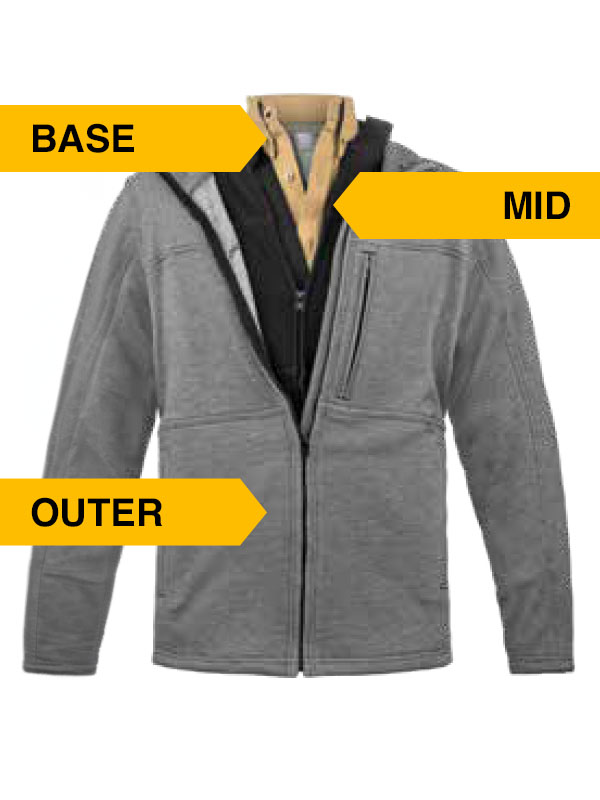The drier the garment the better your body can thermo-regulate itself. Moisture-soaked clothes act as a heat blanket and add to an increased body temperature. When permanent moisture wicking technology is worked into FR apparel at the fabric level, with the optimal blend of hydrophilic and hydrophobic fibers, this offers wearers a better chance at regulating their body temperature on the job. Be careful of any fabric that promotes moisture wicking that is 100% hydrophobic, like FR cotton, as this fabric has a finish on it that will eventually wash out – making the prevention of cold and heat stress far more challenging.
As the cold winter months approach, workers who deal with flash fire and/or arc flash in the outdoor elements face a new hazard: cold stress.

How does cold stress work?
Like heat stress, the core issue of cold stress is the body’s inability to regulate temperature, which is largely impacted by the amount of moisture left in your garments.
When excess moisture, sweat, stays on your skin, your clothes remain soaked, and you trap it inside with outerwear that doesn’t wick moisture or let’s in the outside elements, it becomes impossible to warm up quickly.
This dangerous scenario can result in:
- Cold, tingling, stinging, or aching feeling in the frostbitten area, followed by numbness
- Skin turning red, then purple, then white or very pale skin – cold to the touch
- Hard or blistering skin in severe cases
How can moisture wicking help prevent cold stress?
There’s a key feature that workwear is often missing when it comes to cold stress management, and that is moisture wicking. You’ve likely heard of this technology before for apparel used by the world’s top athletes to enhance performance and push themselves further for competition. High performance fabrics were originally created to boost an athlete’s performance in extreme outdoor situations by keeping them drier and cooler in hot conditions and warmer and drier in cold weather.
So, what is its place in FR workwear?
To give a garment moisture wicking properties, the material should utilize a blend of hydrophobic and hydrophilic fibers, simultaneously pushing and pulling moisture away from the skin and throughout the garment. As one works and (inevitably) sweats, this fiber blend both attracts that excess moisture away from the body and into the garment itself, while also pushing, or spreading, the moisture onto the outside of the garment – making it easier for the apparel to dry faster.

Moisture Wicking and FR Layering for Cold Stress
Moisture wicking technology, when effectively implemented, is helpful with a single FR garment; however, blistering winter conditions often require the addition of several layers to stay dry and warm. Enter the art of layering.
Consider this scenario: You are outside working on a very cold, possibly windy day. The base layer garment next to your skin is a cotton t-shirt or non-moisture wicking fabric. You layer up with a mid-weight layer or hoodie jacket that does not wick moisture or keep out the elements. When your level of exertion subsides, your base layer garment is soaked, gets cold, and your body can not warm itself and cold stress ensues. Add to it your outerwear that doesn’t move moisture and lets the elements in, and you have a disaster starting.
Thankfully, correctly layering FR workwear can further prevent this hazard. In the scenario above, you chose garments that don’t utilize a blend of hydrophobic and hydrophilic fibers (permanent moisture wicking) and, when layered on top of each other, further contribute to keeping moisture close to the skin and in your garments. With nowhere to go, the moisture remains trapped and can further drive down the temperature of your body. The key is to have permanent moisture wicking properties in every layer you add, from base layers to mid layers to outer layers – layering from the inside out – not outside in.
To layer and see the full benefits of FR with moisture wicking technology, you must understand the layering process:
- Base Layer – the layer closest to your skin that should incorporate permanent moisture wicking properties. This is your first line of defense against cold stress.
- Mid Layer – called the “insulating layer”, the mid layer pulls moisture away from the base layer, which is actively working to keep moisture away from your skin. Here is where you put on different weights of garments to maintain warmth.
- Outer Layer – the heaviest, outer-most layer whose primary job is to protect your body from the elements (rain, wind, snow) while wicking moisture and offering breathability

Master the Art of Layering
If you’re new to the art of layering, remember these critical factors:
Choose a base layer that has optimal moisture management.
- Look for inherent, permanent moisture management to ensure the moisture wicking properties will last for the life of the garment and do utilize a finish that will eventually wash out.
- Prioritize finding the optimal blend of fibers that will push and pull moisture through the fabric and spread it faster, which helps it to dry more effectively.
- Ask for the data and be wary of misleading language.
Choose mid-layers that offer you options during varying outdoor conditions.
- Use different weights during changing conditions to get the most longevity and versatility out of your mid-layers.
- Make sure inherent moisture management is present in your mid-layers to bring moisture away more continually from the body.
Choose outer wear that offers wind, rain, and snow protection.
- Since these garments come in contact with external elements like rain and snow, it’s important that your outer layers also have inherent, permanent moisture management.
- Outerwear should be clearly defined as offering protection from wind and rain.
- Remember to layer from the inside out and not from the outside in. This combination keeps you warmer and drier.
Moisture Wicking, Layering, and High-Performance FR
When the winter months hit, look for FR gear that is going to prioritize keeping your body temperature regulated through a combination of moisture wicking, proper layering, and ergonomic designs that prioritize safety and comfort. Cold stress can affect anyone; but, armed with this knowledge and the right FR workwear, you can avoid this hazard and focus on the job at hand.

Lakeland Industries’ Brad Sipe has spent the last two decades of his career dedicated to the innovation and development of industry-leading FR workwear. From authoring white papers, headlining speaking events, and researching FR technology, Brad’s knowledge of product design and flame-resistant fabrics has resulted in a transformative, award-winning High Performance FR product line exclusively from Lakeland Industries.
Training & Consulting
Whatever your industry, Arbill is committed to helping your company ensure workplace safety. Our full suite of safety training and consulting options, including site assessments and audits, gap analysis, staff augmentation and industrial hygiene services are provided by highly experienced and certified EHS professionals.
I WANT TO LEARN MORE ABOUT ARBILL’S COMPREHENSIVE APPROACH TO SAFETY!
*All fields are required.















